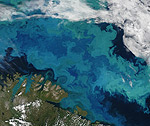This NASA satellite image shows a massive phytoplankton bloom — more than 500 miles long and several hundred miles wide — in the Barents Sea, a frigid body of water located north of Norway and Russia.
The bloom occurred north of the Scandinavian peninsula, an area where multiple ocean current systems merge into the North Cape Current. While it is common for blooms to spread hundreds, or even thousands, of miles across the North Atlantic and Arctic waters — especially in August in the Barents Sea — it is rare to get such a clear view since the sea is covered by clouds most of the summer. The milky blue color suggests the presence of coccolithophores, a microscopic plankton containing white calcium carbonate, which when viewed through ocean water appears bright blue. In the Arctic, the annual spring phytoplankton blooms, triggered by melting sea ice, play a key role in the region’s marine ecology
NASA Satellite Captures Huge Algal Bloom in Barents Sea
More From E360
-
Energy
Facing a Hostile Administration, U.S. Offshore Wind Is in Retreat
-
Biodiversity
As Jaguars Recover, Will the Border Wall Block Their U.S. Return?
-
WATER
An E.U. Plan to Slash Micropollutants in Wastewater Is Under Attack
-
INTERVIEW
This Data Scientist Sees Progress in the Climate Change Fight
-
Climate
As Floods Worsen, Pakistan Is the Epicenter of Climate Change
-
Climate
Heat Stress Is a Major Driver of India’s Kidney Disease Epidemic
-
Energy
It’s a ‘Golden Age’ for U.S. LNG Industry, But Climate Risks Loom
-
Climate
How Climate Risks Are Putting Home Insurance Out of Reach
-
INTERVIEW
Inside the Plastics Industry Playbook: Delay, Deny, and Distract
-
Biodiversity
Freeing Captive Bears from Armenia’s Backyards and Basements
-
Food & Agriculture
In Indonesia’s Rainforest, a Mega-Farm Project Is Plowing Ahead
-
FILM CONTEST WINNER
In the Yucatan, the High Cost of a Boom in Factory Hog Farms
